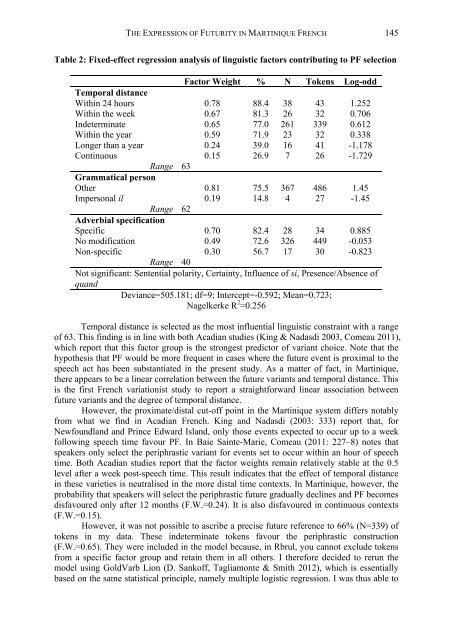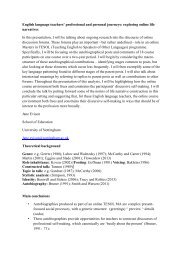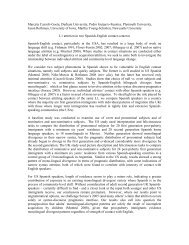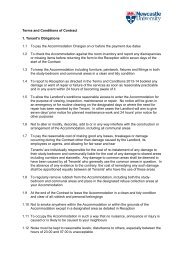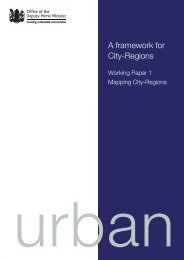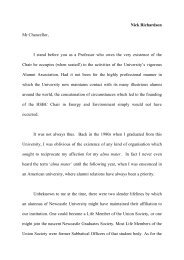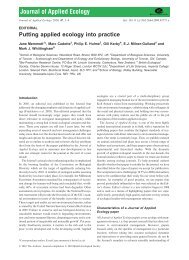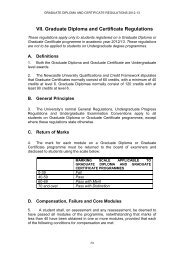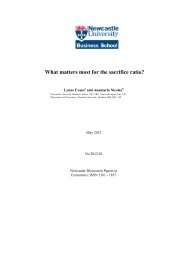the influence of linguistic factors on the expression of futurity
the influence of linguistic factors on the expression of futurity
the influence of linguistic factors on the expression of futurity
Create successful ePaper yourself
Turn your PDF publications into a flip-book with our unique Google optimized e-Paper software.
THE EXPRESSION OF FUTURITY IN MARTINIQUE FRENCH 145<br />
Table 2: Fixed-effect regressi<strong>on</strong> analysis <str<strong>on</strong>g>of</str<strong>on</strong>g> <str<strong>on</strong>g>linguistic</str<strong>on</strong>g> <str<strong>on</strong>g>factors</str<strong>on</strong>g> c<strong>on</strong>tributing to PF selecti<strong>on</strong><br />
Factor Weight % N Tokens Log-odd<br />
Temporal distance<br />
Within 24 hours 0.78 88.4 38 43 1.252<br />
Within <str<strong>on</strong>g>the</str<strong>on</strong>g> week 0.67 81.3 26 32 0.706<br />
Indeterminate 0.65 77.0 261 339 0.612<br />
Within <str<strong>on</strong>g>the</str<strong>on</strong>g> year 0.59 71.9 23 32 0.338<br />
L<strong>on</strong>ger than a year 0.24 39.0 16 41 -1.178<br />
C<strong>on</strong>tinuous 0.15 26.9 7 26 -1.729<br />
Range 63<br />
Grammatical pers<strong>on</strong><br />
O<str<strong>on</strong>g>the</str<strong>on</strong>g>r 0.81 75.5 367 486 1.45<br />
Impers<strong>on</strong>al il 0.19 14.8 4 27 -1.45<br />
Range 62<br />
Adverbial specificati<strong>on</strong><br />
Specific 0.70 82.4 28 34 0.885<br />
No modificati<strong>on</strong> 0.49 72.6 326 449 -0.053<br />
N<strong>on</strong>-specific 0.30 56.7 17 30 -0.823<br />
Range 40<br />
Not significant: Sentential polarity, Certainty, Influence <str<strong>on</strong>g>of</str<strong>on</strong>g> si, Presence/Absence <str<strong>on</strong>g>of</str<strong>on</strong>g><br />
quand<br />
Deviance=505.181; df=9; Intercept=-0.592; Mean=0.723;<br />
Nagelkerke R 2 =0.256<br />
Temporal distance is selected as <str<strong>on</strong>g>the</str<strong>on</strong>g> most influential <str<strong>on</strong>g>linguistic</str<strong>on</strong>g> c<strong>on</strong>straint with a range<br />
<str<strong>on</strong>g>of</str<strong>on</strong>g> 63. This finding is in line with both Acadian studies (King & Nadasdi 2003, Comeau 2011),<br />
which report that this factor group is <str<strong>on</strong>g>the</str<strong>on</strong>g> str<strong>on</strong>gest predictor <str<strong>on</strong>g>of</str<strong>on</strong>g> variant choice. Note that <str<strong>on</strong>g>the</str<strong>on</strong>g><br />
hypo<str<strong>on</strong>g>the</str<strong>on</strong>g>sis that PF would be more frequent in cases where <str<strong>on</strong>g>the</str<strong>on</strong>g> future event is proximal to <str<strong>on</strong>g>the</str<strong>on</strong>g><br />
speech act has been substantiated in <str<strong>on</strong>g>the</str<strong>on</strong>g> present study. As a matter <str<strong>on</strong>g>of</str<strong>on</strong>g> fact, in Martinique,<br />
<str<strong>on</strong>g>the</str<strong>on</strong>g>re appears to be a linear correlati<strong>on</strong> between <str<strong>on</strong>g>the</str<strong>on</strong>g> future variants and temporal distance. This<br />
is <str<strong>on</strong>g>the</str<strong>on</strong>g> first French variati<strong>on</strong>ist study to report a straightforward linear associati<strong>on</strong> between<br />
future variants and <str<strong>on</strong>g>the</str<strong>on</strong>g> degree <str<strong>on</strong>g>of</str<strong>on</strong>g> temporal distance.<br />
However, <str<strong>on</strong>g>the</str<strong>on</strong>g> proximate/distal cut-<str<strong>on</strong>g>of</str<strong>on</strong>g>f point in <str<strong>on</strong>g>the</str<strong>on</strong>g> Martinique system differs notably<br />
from what we find in Acadian French. King and Nadasdi (2003: 333) report that, for<br />
Newfoundland and Prince Edward Island, <strong>on</strong>ly those events expected to occur up to a week<br />
following speech time favour PF. In Baie Sainte-Marie, Comeau (2011: 227–8) notes that<br />
speakers <strong>on</strong>ly select <str<strong>on</strong>g>the</str<strong>on</strong>g> periphrastic variant for events set to occur within an hour <str<strong>on</strong>g>of</str<strong>on</strong>g> speech<br />
time. Both Acadian studies report that <str<strong>on</strong>g>the</str<strong>on</strong>g> factor weights remain relatively stable at <str<strong>on</strong>g>the</str<strong>on</strong>g> 0.5<br />
level after a week post-speech time. This result indicates that <str<strong>on</strong>g>the</str<strong>on</strong>g> effect <str<strong>on</strong>g>of</str<strong>on</strong>g> temporal distance<br />
in <str<strong>on</strong>g>the</str<strong>on</strong>g>se varieties is neutralised in <str<strong>on</strong>g>the</str<strong>on</strong>g> more distal time c<strong>on</strong>texts. In Martinique, however, <str<strong>on</strong>g>the</str<strong>on</strong>g><br />
probability that speakers will select <str<strong>on</strong>g>the</str<strong>on</strong>g> periphrastic future gradually declines and PF becomes<br />
disfavoured <strong>on</strong>ly after 12 m<strong>on</strong>ths (F.W.=0.24). It is also disfavoured in c<strong>on</strong>tinuous c<strong>on</strong>texts<br />
(F.W.=0.15).<br />
However, it was not possible to ascribe a precise future reference to 66% (N=339) <str<strong>on</strong>g>of</str<strong>on</strong>g><br />
tokens in my data. These indeterminate tokens favour <str<strong>on</strong>g>the</str<strong>on</strong>g> periphrastic c<strong>on</strong>structi<strong>on</strong><br />
(F.W.=0.65). They were included in <str<strong>on</strong>g>the</str<strong>on</strong>g> model because, in Rbrul, you cannot exclude tokens<br />
from a specific factor group and retain <str<strong>on</strong>g>the</str<strong>on</strong>g>m in all o<str<strong>on</strong>g>the</str<strong>on</strong>g>rs. I <str<strong>on</strong>g>the</str<strong>on</strong>g>refore decided to rerun <str<strong>on</strong>g>the</str<strong>on</strong>g><br />
model using GoldVarb Li<strong>on</strong> (D. Sank<str<strong>on</strong>g>of</str<strong>on</strong>g>f, Tagliam<strong>on</strong>te & Smith 2012), which is essentially<br />
based <strong>on</strong> <str<strong>on</strong>g>the</str<strong>on</strong>g> same statistical principle, namely multiple logistic regressi<strong>on</strong>. I was thus able to


